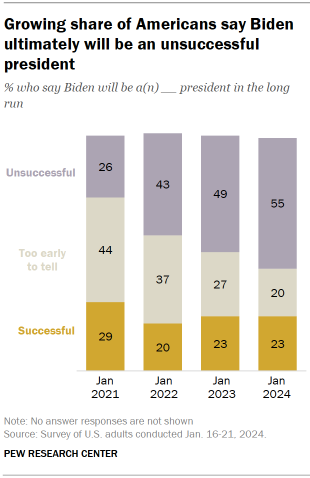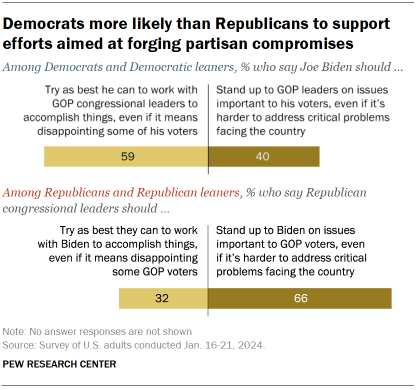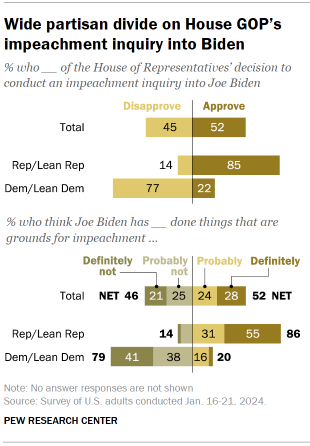Rubén Weinsteiner
Americans More Upbeat on the Economy; Biden’s Job Rating Remains Very Low
In their own words: How people feel about the economy
Americans’
views of the nation’s economy – while mostly stagnant for the past few
years – are showing signs of improvement. Slightly more than a quarter
(28%) rate economic conditions as excellent or good, a 9 percentage
point increase from last April.
Virtually
all the change since then has come among Democrats and
Democratic-leaning independents. Currently, 44% of Democrats have
positive views of the economy – the highest share of Joe Biden’s
presidency.
The new survey by Pew Research Center, conducted
Jan. 16-21 among 5,140 adults, finds that Biden’s own job rating remains
highly negative: Just 33% of Americans approve of his job performance,
unchanged from last month.
The economy, past and future; top concerns
Despite
the improvement in economic attitudes, the public is far less upbeat
today than it was from 2018 through early 2020, during Donald Trump’s
presidency and prior to the outbreak of the coronavirus pandemic. 
Economic
ratings remain far less positive than before the pandemic. In January
2020, 57% of Americans rated economic conditions as excellent or good; positive ratings fell to 23% in April of that year,
as the coronavirus outbreak spread across the country. Views of the
economy improved early during Biden’s first few months in office but
declined subsequently.
The public’s future economic outlook
turns less negative. The share of Americans saying economic conditions
will be worse a year from now has fallen from 46% last April to 33%
today.
However, more continue to say that conditions will be
worse than better (26%) next year; 41% expect the economy will be about
the same as it is today.
There’s less concern about energy
prices and the stock market. A sizable majority of Americans (72%) say
they are very concerned about prices for food and consumer goods, little
changed from last year. The cost of housing also is a major issue, with
64% very concerned.
However, the shares expressing a great deal
of concern about prices of gasoline and energy and how the stock market
is doing have declined 9 points and 8 points, respectively, since last
January.
In their own words: Americans on the economy 
When
the majority of Americans who rate economic conditions poor or only
fair are asked why they feel this way, most point to inflation or high
prices. Nearly half (45%) specifically mention high inflation (28%) or
the high cost of living (21%); 11% specifically point to the high cost
of food and groceries or the cost of housing.
People who view
the economy positively – those who rate conditions as excellent or good –
most often say low unemployment is a major reason why they feel the way
they do (43% say this). Other factors cited are that inflation has come
down (18%), wage growth (10%), or the strong performance of the stock
market (9%).
Biden’s job performance, personal traits
Currently,
33% of Americans approve of Joe Biden’s job performance, while 65%
disapprove. Biden’s job rating has not been above 40% since April 2022. 
Young
adults are negative about Biden’s job performance. Biden’s job rating
is low across all age groups, including young adults. Just 27% of adults
ages 18 to 29 approve of the way Biden is handling his job as
president, while 71% disapprove.
Black adults are divided over
Biden. About as many Black adults disapprove (49%) as approve (48%) of
Biden’s job performance. Biden’s job rating is lower among Asian (39%),
Hispanic (32%) and White (30%) adults.
Views of Biden’s personal
traits have grown less positive. Biden gets his most positive ratings
for being even-tempered (62% say this phrase describes him very or
fairly well) and standing up for what he believes in (50%).
Far
fewer Americans describe him as mentally sharp (29%), inspiring (26%) or
energetic (24%). For the most part, perceptions of Biden’s personal
traits have followed the same downward trajectory as his job ratings.
Judgments on Biden’s legacy 
The
share of Americans saying that Biden will be an unsuccessful president
in the long run has increased steadily over the course of his
administration.
Currently, 55% say he will be an unsuccessful
president while just 23% say he will be successful; 20% say it is too
early to tell. These opinions, like other views of Biden, are deeply
partisan: Republicans overwhelmingly say Biden will be unsuccessful
(87%).
Among Democrats, 45% say he will be successful, 26% say unsuccessful, and 28% say it is too early to tell.
Other findings on partisan compromise and the House GOP impeachment inquiry 
A
majority of Democrats (59%) say Biden should try his best to work with
GOP leaders to accomplish things, even if that disappoints some of his
voters; only 32% of Republicans say the same of GOP leaders trying to
reach compromises with Biden. These opinions have changed little over
the course of Biden’s presidency.
During the Trump administration,
Democrats were less likely to say their party’s leaders should seek
compromise with Trump than Republicans were to say their party should
try to seek political compromise with Democratic leaders. 
About
half of Americans (52%) approve of House Republicans’ decision to
conduct an impeachment inquiry into Joe Biden, while 45% disapprove.
These opinions – and views about whether Biden has done anything that is
grounds for his impeachment – are deeply divided along partisan lines:
85% of Republicans approve of the inquiry, while 77% of Democrats
disapprove.
Relatively few Americans (16%) say they are
following news about the impeachment inquiry launched by House
Republicans into Biden’s conduct and possible connections to his son
Hunter’s business dealings extremely or very closely.
Views of the nation’s economy
About three-in-ten Americans (28%) currently rate national economic conditions as excellent or good, while a similar share (31%) say they are poor and about four-in-ten (41%) view them as “only fair.”
While ratings remain substantially lower than they were prior to the start of the COVID-19 pandemic, they are more positive than they were last spring – when just 19% viewed the economy in positive terms.

Expectations for future economic conditions are also more positive than they were last spring: Today, roughly a quarter say that they expect economic conditions will be better a year from now (26%) – up from 17% in April 2023.
At the same time, the share who says conditions will be worse has declined by 13 percentage points. About four-in-ten say they expect conditions will be about the same.
As has long been the case, partisans who share the party of the president have more positive views of economic conditions than those who support the opposing party. Today, 44% of Democrats and Democratic leaners say the nation’s economy is excellent or good. This compares with 13% of Republicans and GOP leaners.
Similarly, Democrats are more likely than Republicans to say they expect economic conditions a year from now will be better than they are today: 34% of Democrats say this, compared with 20% of Republicans.
There are substantial differences among Democrats in views of the nation’s economy – particularly by age and income.

Younger Democrats are much less likely than older Democrats to view current economic conditions in positive terms. Among Democrats under 30, a quarter view the economy positively. This share rises to 34% among those ages 30 to 49, 56% among those 50 to 64, and 70% among those 65 and older.
There are also significant differences by race and ethnicity. White Democrats are more likely than Black, Hispanic and Asian Democrats to say the economy is excellent or good.
Democrats in different income groups also diverge in their evaluations of the nation’s economy. Democrats with higher household incomes are more positive about economic conditions than Democrats with lower incomes. A clear majority of upper-income Democrats (60%) say the economy is doing excellent or good. By comparison, 32% of those with lower incomes view the economy positively, while a majority say it is only fair (40%) or poor (28%).
Across Republican groups, economic assessments vary less drastically. Republicans overwhelmingly rate the economy negatively: Just 15% or less across demographic groups say national economic conditions are good or excellent.
However, there are some differences in how negative GOP assessments are. For instance, upper-income Republicans are more likely to say the economy is doing only fair (48%) rather than poorly (36%), while lower-income Republicans are more likely to say poor (49%) rather than only fair (38%).
Why do Americans rate the nation’s economy as they do?
In an open-ended question which asked Americans to explain the reasons for their overall evaluation of the nation’s economy (as excellent, good, only fair, or poor), people provide wide-ranging answers.

Among the 28% of Americans who say the nation’s economy is doing excellent or good, many offer overwhelmingly positive reasons for why they rate the economy this way. A large share (43%) note the country’s low unemployment, while 18% say that inflation is coming down or is lower than it has been in recent months. Roughly one-in-ten mention wage growth, while a similar share (9%) say strong stock market performance contributes to their rating. And 5% say the reason for their rating is that the U.S. is outperforming expectations or otherwise doing better than other countries in terms of economic growth.
Among the 72% of adults who say the economy is doing only fair or poor, most offer negative reasons for why they rate the economy the way they do. Those who say the economy is only fair are slightly more likely to offer a mix of positive and negative responses than those who say the economy is poor. However, respondents in both groups offer similar reasons for their ratings.
Among those who say the nation’s economy is only fair or poor, high inflation or high costs of various goods are frequently mentioned: 28% say high inflation is a main reason they evaluate the economy as only fair or poor, while roughly two-in-ten cite the high cost of living. Along this same theme, 6% point to the high cost of food and groceries while identical shares say the high cost of housing and high interest rates are a main reason they view the economy as doing only fair or poor.
Other issues are also mentioned: 15% say the lack of good paying jobs or low wages is a major reason for their rating while 7% point to the national debt and government spending. Another 5% give a negative response about Biden’s or Democrats’ economic policies more broadly.
Cost of goods, housing remain top economic concerns

Majorities of Americans continue to express a high level of concern about the price of food and consumer goods (72% say they are very concerned about this) and the cost of housing (64%). About half (51%) say they are very concerned about the price of gasoline and energy. More than eight-in-ten say they are at least somewhat concerned about each of these economic issues.
Other economic issues rank lower on the public’s list of concerns. Smaller shares of Americans say they are very concerned about the stability of banks and financial institutions (27%), people who want to work being unable to find jobs (31%) or the performance of the stock market (18%).
Majorities in both parties are very concerned about the cost of goods and housing

Republicans and Democrats are fairly aligned in their economic concerns. Majorities in both groups say they are very concerned about the cost of food, consumer goods and housing. And substantially smaller shares express concern about the stability of banks or the performance of the stock market.
However, Republican concern about the price of food and consumer goods is more widespread than Democratic concern (82% vs. 63%). And the partisan gap on concerns about the price of gasoline and energy is even wider: A 64% majority of Republicans say they are very concerned about the cost of gas, compared with 40% of Democrats.
Partisans’ expectations for the year ahead
As has been the case for the last three years, Democrats are more likely than Republicans to say the upcoming year will be better than the last. Two-thirds of Democrats say 2024 will be better than 2023, while 43% of Republicans say the same.

This dynamic in feelings about the new year – with Democrats expressing more optimism than Republicans – has held true since 2021. Then, 83% of Democrats said 2021 would be better than 2020 while 48% of Republicans agreed.
In 2020, the pattern was the reverse. Republicans were more likely to say 2020 would be better than 2019 compared with Democrats (78% vs. 36%, respectively).
In Pew Research Center surveys dating back to 2006 (when the question was first asked), Americans who identify with or lean toward the president’s party have tended to be more optimistic about the coming year than those who associate with the opposing party.
Rubén Weinsteiner


